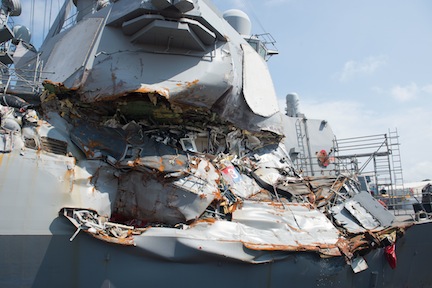The following is the text of a news report from the U.S. Naval Institute (USNI):
(WASHINGTON) — The fatal collisions involving two guided-missile destroyers, USS John S. McCain and USS Fitzgerald, and two merchant ships were rooted in fundamental failures in the Navy crews' ability to operate their ships effectively, according to a summary of two investigations the Navy released to the public on Wednesday.
“Both of these accidents were preventable and the respective investigations found multiple failures by watch standers that contributed to the incidents," said Chief of Naval Operations Adm. John Richardson in a prepared statement. “We must do better.”
In the case of the June 17 collision between Fitzgerald and merchant ship ACX Crystal off the coast of Japan, investigators found that the Navy crew did not understand fundamental rules of maritime transit and did not understand their radars sufficiently. While in transit, the watch lost awareness of the position of the merchant ship and didn’t rouse the commander for assistance when it was clear the ship was in danger. Seven sailors were killed.
“The crew was unprepared for the situation in which they found themselves through a lack of preparation, ineffective command and control, and deficiencies in training and preparations for navigation,” read the findings of the summary.
For the Aug. 21 collision of McCain in the busy Strait of Malacca near Singapore, investigators found that a less experienced watch team populated by sailors from the damaged cruiser USS Antietam (CG 54) was on duty when the ship entered the waterway. A misunderstanding of how the steering controls on the ship were configured led to a loss of control of the ship two minutes before the collision with the merchant tanker Alnic MC. The impact of the tanker ripped a hole in the hull, flooding three berthing areas and drowning 10 sailors who were unable to escape from the spaces.
Both crews did not attempt to contact the merchant ship bearing down on them, sound a warning horn, sound a collision warning or sound general quarters before the impacts.
Early results from both investigations have resulted in the removal of the commanders and executive officers of both ships: Capt. Jeffery Bennett, commodore of the Japan-based Destroyer Squadron 15 to which both ships belonged; the Japan-based task force commander Rear Adm. Charles Williams; and the commander of U.S. 7th Fleet, Vice Adm. Joseph Aucoin.
While not directly related to the findings of the investigations, U.S. Surface Forces commander Vice Adm. Tom Rowden has requested early retirement and U.S. Pacific Fleet commander Adm. Scott Swift was passed over for consideration to be the next U.S. Pacific Command head.
Additionally, the Navy is set to roll out a comprehensive review into the underlying causes that allowed the lapses to occur, overseen by U.S. Fleet Forces commander Adm. Phil Davidson.
“We are a Navy that learns from mistakes and the Navy is firmly committed to doing everything possible to prevent an accident like this from happening again,” Richardson said. “We must never allow an accident like this to take the lives of such magnificent young sailors and inflict such painful grief on their families and the nation.”
Click here to read the complete Navy report.

